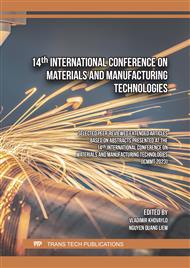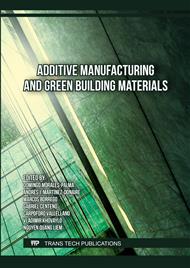[1]
A. Varesano, A. Aluigi, L. Florio, R. Fabris: Multifunctional cotton fabrics, Synth Metal Vol. 159, pp.1082-1089 (2009)
DOI: 10.1016/j.synthmet.2009.01.036
Google Scholar
[2]
M.S. Yen, H.C. Tsai, P.D. Hong: The physical properties of aqueous cationic–nonionic polyurethane with poly(ethylene glycol methyl ether) side chain and its blend with aqueous cationic polyurethane, Journal of Applied Polymer Science, Vol. 100, Issue 4, pp.2963-2974 (2006)
DOI: 10.1002/app.22852
Google Scholar
[3]
H.C. Tsai, P.D. Hong, M.S. Yen: Preparation and Physical Properties of MDEA-based Polyurethane Cationomers and their Application to Textile Coatings, Textile Research Journal, Vol. 77, Issue 9, pp.710-720 (2007)
DOI: 10.1177/0040517507080544
Google Scholar
[4]
D.A. Holmes: Waterproof breathable fabrics, A.R. Horrocks, S.C. Anand (Eds.), Handbook of Technical Textiles, Woodhouse Publishing Ltd., Cambridge, p.282 (2000)
DOI: 10.1533/9781855738966.282
Google Scholar
[5]
S. Mondal, J.L. Hu: Structural characterization and mass transfer properties of nonporous segmented polyurethane membrane: Influence of hydrophilic and carboxylic group, Journal of Membrane Science, Vol. 274, Issue 1-2, pp.219-226 (2006)
DOI: 10.1016/j.memsci.2005.08.016
Google Scholar
[6]
J. Wu, N. Wang, L. Wang, H. Dong, Y. Zhao and L. Jiang: Electrospun Porous Structure Fibrous Film with High Oil Adsorption Capacity, ACS Applied Materials & Interfaces, Vol. 4, Issue 6, p.3207–3212 (2012)
DOI: 10.1021/am300544d
Google Scholar
[7]
C.J. Camphuysen and M. Heubeck: Marine Oil Pollution and Beached Bird Surveys: the development of a sensitive monitoring instrument, Environmental Pollution, Vol. 112, Issue 3, p.443–461 (2001)
DOI: 10.1016/s0269-7491(00)00138-x
Google Scholar
[8]
C.M. Wu and M.H. Chou: Polymorphism, Piezoelectricity and Sound Absorption of Electrospun PVDF Membranes with and Without Carbon Nanotubes, Composites Science and Technology, Vol. 127, p.127–133 (2016)
DOI: 10.1016/j.compscitech.2016.03.001
Google Scholar
[9]
J. Mohrova and K. Kalinova: Different Structures of PVA Nanofiberous Membrane for Sound Absorption Application: Journal of Nanomaterials-Special issue on Nanofiber Manufacture, Vol. 2012, No. 11 (2012)
DOI: 10.1155/2012/643043
Google Scholar
[10]
Xuanxuan Du and Binjie Xin: Waterproof and Moisture permeable Nanofibrous Membranes with Cross-Linked Structure, Journal of Physics: Conference Series, Vol. 1790 (2020)
DOI: 10.1088/1742-6596/1790/1/012069
Google Scholar
[11]
Y. Yu, F. Zhang, Y. Liu, Y. Zheng, B. Xin, Z. Jiang, X. Peng and S. Jin: Waterproof and breathable polyacrylonitrile/(polyurethane/fluorinated-silica) composite nanofiber membrane via side-by-side electrospinning, Journal of Materials Research, Vol. 35, Issue 9, pp.1173-1181 (2020)
DOI: 10.1557/jmr.2020.88
Google Scholar
[12]
Wu, W., H. Sota, T. Hirogaki, E. Aoyama: Investigation of Air Filter Properties of Nanofiber Non-woven Fabric Manufactured by a Modified Melt-blowing Method Along with Flash Spinning Method, Precision Engineering, Vol. 68, pp.187-196 (2021)
DOI: 10.1016/j.precisioneng.2020.12.010
Google Scholar
[13]
Shinyoung Kim, Ji-Hyun Oh and Chung Hee Park: Development of Energy-Efficient Superhydrophobic Polypropylene Fabric by Oxygen Plasma Etching and Thermal Aging, Polymers, Vol. 12, Issue 11 (2020)
DOI: 10.3390/polym12112756
Google Scholar
[14]
A. UMEDA, F. HORIBATA, C. HIRAI and T. UMEMOTO: Superhydrophobic Surface Made by Injection Molding of Polypropylene Material and its Application to Home Appliance Products, Journal of the Japan Society of Colour Material, Vol. 91, Issue 4, pp.115-120 (2018) (in Japanese)
DOI: 10.4011/shikizai.91.115
Google Scholar



